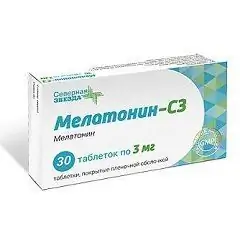- Author Rachel Wainwright [email protected].
- Public 2023-12-15 07:39.
- Last modified 2025-11-02 20:14.
Melatonin-SZ
Melatonin-SZ: instructions for use and reviews
- 1. Release form and composition
- 2. Pharmacological properties
- 3. Indications for use
- 4. Contraindications
- 5. Method of application and dosage
- 6. Side effects
- 7. Overdose
- 8. Special instructions
- 9. Application during pregnancy and lactation
- 10. Use in childhood
- 11. In case of impaired renal function
- 12. For violations of liver function
- 13. Use in the elderly
- 14. Drug interactions
- 15. Analogs
- 16. Terms and conditions of storage
- 17. Terms of dispensing from pharmacies
- 18. Reviews
- 19. Price in pharmacies
Latin name: Melatonin-SZ
ATX code: N05CH01
Active ingredient: melatonin (Melatonin)
Producer: NAO "Severnaya Zvezda" (Russia)
Description and photo update: 2019-08-10
Prices in pharmacies: from 267 rubles.
Buy

Melatonin-SZ is an adaptogenic drug that normalizes physiological sleep and biological rhythms.
Release form and composition
The drug is produced in the form of film-coated tablets: round, biconvex, a dividing line is applied on one side, the shell and core are almost white or white (in blisters of 10 tablets, in a cardboard box 1, 2 or 3 packages; in blisters of 30 tablets, in a cardboard box 1 or 2 packs; in polymer cans / vials of 30 tablets, in a cardboard box 1 can / bottle and instructions for the use of Melatonin-SZ).
1 tablet contains:
- active substance: melatonin - 3 mg;
- auxiliary components: sodium carboxymethyl starch, MCC (microcrystalline cellulose), calcium hydrogen phosphate dihydrate, magnesium stearate;
- the composition of the film shell: polysorbate 80 (tween 80), hypromellose, titanium dioxide (E171), talc.
Pharmacological properties
Pharmacodynamics
Melatonin-C3 is an adaptogenic drug, its active substance is melatonin, is a synthetic analogue of the pineal hormone (pineal gland) and has, along with adaptogenic, sedative and hypnotic effects.
The therapeutic effect of the drug is realized by normalizing circadian rhythms, increasing the concentration of serotonin and GABA (gamma-aminobutyric acid) in the midbrain and hypothalamus. Melatonin affects the change in the activity of pyridoxal kinase, which is involved in the synthesis of dopamine, serotonin and GABA, regulates the sleep and wakefulness cycle, changes in locomotor activity and body temperature that occur during the day. It has a positive effect on the intellectual and mnestic functions of the brain and the emotional and personal sphere.
Melatonin is involved in the organization of biological rhythm and regulation of neuroendocrine functions. Promotes the normalization of sleep at night, speeding up falling asleep and improving the quality of sleep. In people who are sensitive to weather conditions, it helps the body adapt to changes in weather conditions.
Pharmacokinetics
After oral administration, melatonin is rapidly absorbed in the gastrointestinal tract (GIT). When used in a dose of 3 mg, its maximum concentration (C max) in blood plasma is reached after 20 minutes, in blood serum and saliva - 60 minutes. C max in serum when taking melatonin in the dose range from 3 to 6 mg is 10 times higher than the level of endogenous melatonin in blood serum at night. With the simultaneous intake of food, absorption slows down. Against the background of therapeutic doses (2-8 mg), the pharmacokinetics of melatonin remains linear. Bioavailability averages 15%.
Binding of melatonin (in vitro) to plasma proteins (mainly albumin, alpha1-acid glycoprotein, high density lipoproteins) - 60%. The volume of distribution (V d) is approximately 35 liters.
The substance crosses the blood-brain barrier, enters the placenta. The concentration of melatonin in the cerebrospinal fluid is 2.5 times lower than its plasma level.
Melatonin is metabolized mainly in the liver with the participation of isoenzymes of the cytochrome P450 system (CYP1A1, CYP1A2 and, presumably, CYP2C19). It undergoes significant (up to 85% of the dose taken) biotransformation during the initial passage through the liver, by hydroxylation and conjugation with sulfate and glucuronides, with the formation of the main inactive metabolite - 6-sulfatoxymelatonin.
The average half-life (T 1/2) is 45 minutes. It is excreted from the body through the kidneys - approximately 90% in the form of glucuronic and sulfate conjugate of 6-hydroxymelatonin, the rest is unchanged.
The pharmacokinetics of the active substance is influenced by caffeine, smoking, oral contraceptives, and the patient's age. In critically ill patients, absorption is accelerated and elimination is impaired.
In elderly patients, the rate of absorption can be reduced by 50% and the metabolism of melatonin is slowed down.
In case of impaired renal function, prolonged use of Melatonin-SZ does not cause cumulation of the drug.
When liver function is impaired, the level of endogenous melatonin increases. In patients with cirrhosis of the liver during the daytime, the plasma concentration of the drug increases significantly.
Indications for use
The use of Melatonin-SZ is indicated for sleep disorders, including those caused by disturbances in the rhythm of sleep and wakefulness with a sharp change in time zones (desynchrosis).
Contraindications
Absolute:
- liver failure;
- autoimmune pathologies;
- severe renal failure;
- period of pregnancy;
- breast-feeding;
- age up to 18 years;
- hypersensitivity to drug components.
It is recommended to take Melatonin-SZ with caution in case of mild to moderate renal failure.
Melatonin-SZ, instructions for use: method and dosage
Melatonin-SZ tablets are taken orally.
Recommended dosage:
- sleep disturbance: 3 mg once a day 0.5 hours before going to bed;
- desynchrosis (when changing time zones as an adaptogen): 3 mg once a day. The first dose should be taken 1 day before the intended flight, then within 2-5 days it should be continued in the new time zone.
The maximum daily dose of Melatonin-SZ is 6 mg.
Elderly patients should take tablets 1-1.5 hours before bedtime.
Side effects
The incidence of side effects according to the recommendations of the WHO (World Health Organization) [very often (> 0.1); often (from> 0.01 to 0.001 to 0.0001 to <0.001), very rarely (<0.0001, including individual messages); frequency unknown (it is impossible to establish the frequency of occurrence from the available data)]:
- from the lymphatic system and blood: rarely - leukopenia, thrombocytopenia;
- invasions and infections: rarely - herpes zoster;
- mental disorders: infrequently - anxiety, irritability, nervousness, unusual and / or nightmares, anxiety, insomnia; rarely - tearfulness, mood swings, aggression, stress symptoms, disorientation, agitation, early awakening in the morning, increased libido, low mood, depression;
- on the part of the organ of vision: rarely - blurred vision, decreased visual acuity, increased lacrimation;
- from the nervous system: infrequently - lethargy, headache, migraine, dizziness, drowsiness, psychomotor hyperactivity; rarely - poor sleep quality, fainting, impaired memory and / or concentration, restless legs syndrome, delirium, paresthesia;
- on the part of the organ of hearing, labyrinth disorders: rarely - dizziness, benign paroxysmal positional vertigo (BPPV);
- on the part of the cardiovascular system: infrequently - arterial hypertension; rarely - hot flashes, palpitations, exertional angina;
- from the side of metabolism and nutrition: rarely - hypokalemia, hyponatremia, hypertriglyceridemia;
- from the digestive system: infrequently - dry mouth, ulcerative stomatitis, nausea, abdominal pain (including the upper abdomen), dyspepsia, hyperbilirubinemia; rarely - bad breath, salivary hypersecretion, ulcerative glossitis, vomiting, bullous stomatitis, increased peristalsis, gastrointestinal upset, bloating, abdominal discomfort, gastroesophageal reflux disease, stomach dyskinesia, gastritis;
- from the immune system: the frequency is not established - hypersensitivity reactions;
- dermatological reactions: infrequently - dry skin, itching (including generalized itching), sweating at night, rash, dermatitis; rarely - erythema, hand dermatitis, itchy rash, generalized rash, nail damage, eczema, psoriasis; frequency not established - Quincke's edema, swelling of the tongue and / or oral mucosa;
- from the urinary system: infrequently - proteinuria, glucosuria; rarely - nocturia, polyuria, hematuria;
- from the musculoskeletal system and connective tissue: infrequently - pain in the limbs; rarely - neck pain, muscle spasm, night cramps, arthritis;
- from the genitals and breast: infrequently - symptoms of menopause; rarely - prostatitis, priapism; frequency not established - galactorrhea;
- laboratory changes: infrequently - abnormal liver function indicators, increased body weight; rarely - deviation from the normal results of laboratory tests, increased activity of hepatic transaminases, changes in the content of electrolytes in the blood;
- general disorders: infrequently - chest pain, asthenia; rarely - thirst, fatigue, pain.
Overdose
- Symptoms: involuntary loss of consciousness while using 1000 mg of melatonin. When Melatonin-SZ is taken in doses exceeding 3000 mg for several weeks, abdominal cramps, diarrhea, drowsiness, hyperemia, headache and scotoma may develop;
- treatment: immediate gastric lavage, intake of activated charcoal. Appointment of symptomatic therapy. After oral administration, the active substance is spontaneously excreted from the body within about 12 hours.
special instructions
During the treatment period, exposure to bright light should be avoided.
The simultaneous use of alcoholic beverages is contraindicated.
Influence on the ability to drive vehicles and complex mechanisms
Since the action of the drug causes drowsiness, reduces the speed of psychomotor reactions and concentration of attention, during the period of using Melatonin-SZ, one should refrain from driving and performing other potentially hazardous activities.
Application during pregnancy and lactation
The use of Melatonin-SZ is contraindicated during pregnancy and lactation.
Women planning pregnancy should take into account that the drug has a weak contraceptive effect.
Pediatric use
Persons under the age of 18 should not take Melatonin-SZ tablets.
With impaired renal function
The use of Melatonin-SZ is contraindicated in patients with severe renal failure.
Caution should be exercised in patients with renal insufficiency of varying severity.
For violations of liver function
The use of Melatonin-SZ is contraindicated in liver failure.
Use in the elderly
Elderly patients should take the tablets 60-90 minutes before bedtime.
Drug interactions
With simultaneous use with Melatonin-SZ:
- fluvoxamine: inhibits the metabolism of melatonin, which leads to a significant increase in the concentration of the latter in the blood; it is recommended to avoid this combination;
- 5- and 8-methoxypsoralen: when combined with these agents, care should be taken due to an increase in the concentration of melatonin;
- cimetidine (an inhibitor of CYP2D isoenzymes): promotes an increase in plasma melatonin;
- estrogen-containing drugs (including oral contraceptives): against the background of concomitant hormone replacement therapy, the concentration of melatonin increases;
- quinolones and other inhibitors of CYPA2 isoenzymes: may increase exposure to melatonin;
- carbamazepine, rifampicin (inducers of the isoenzyme CYP1A2): contribute to a decrease in the plasma concentration of melatonin;
- nicotine: in smokers, the concentration of melatonin may decrease;
- hypnotics benzodiazepine and non-benzodiazepine series: melatonin potentiates the sedative effect of zaleplon, zolpidem, zopiclone. The consequence of the combination with these agents can be a progressive disorder of coordination, attention and memory;
- thioridazine, imipramine: co-administration of drugs affecting the central nervous system does not cause clinically significant pharmacokinetic interaction with melatonin. Perhaps an increase in the feeling of calmness, difficulty in performing certain actions, an increase in the feeling of clouding in the head;
- ethanol: Drinking alcohol and ingestion of ethanol-containing drugs reduce the effectiveness of Melatonin-SZ.
Analogs
Melatonin-SZ analogs are Kakspal Neo, Melarena, Melaxen, Melaxen Balance, Melarithm, Sonnovan, Circadin, etc.
Terms and conditions of storage
Keep out of the reach of children.
Store at temperatures up to 25 ° C in a dark place.
The shelf life is 3 years.
Terms of dispensing from pharmacies
Available without a prescription.
Reviews about Melatonin-SZ
Reviews about Melatonin-SZ are positive. Pointing to the effectiveness of the drug, patients report that its use provides fast falling asleep and good healthy sleep. Adaptogenic properties make it easier to tolerate significant time differences when changing time zones.
Price for Melatonin-SZ in pharmacies
The price for Melatonin-SZ for a package containing 30 tablets can be from 280 rubles, for a package containing 60 tablets - from 388 rubles.
Melatonin-SZ: prices in online pharmacies
|
Drug name Price Pharmacy |
|
Melatonin-SZ 3 mg film-coated tablets 30 pcs. 267 r Buy |
|
Melatonin-SZ tablets p.o. 3mg 30 pcs. 288 r Buy |
|
Melatonin-SZ tablets p.o. 3mg 60 pcs. 402 RUB Buy |
|
Melatonin-SZ 3 mg film-coated tablets 60 pcs. 402 RUB Buy |

Anna Kozlova Medical journalist About the author
Education: Rostov State Medical University, specialty "General Medicine".
Information about the drug is generalized, provided for informational purposes only and does not replace the official instructions. Self-medication is hazardous to health!






